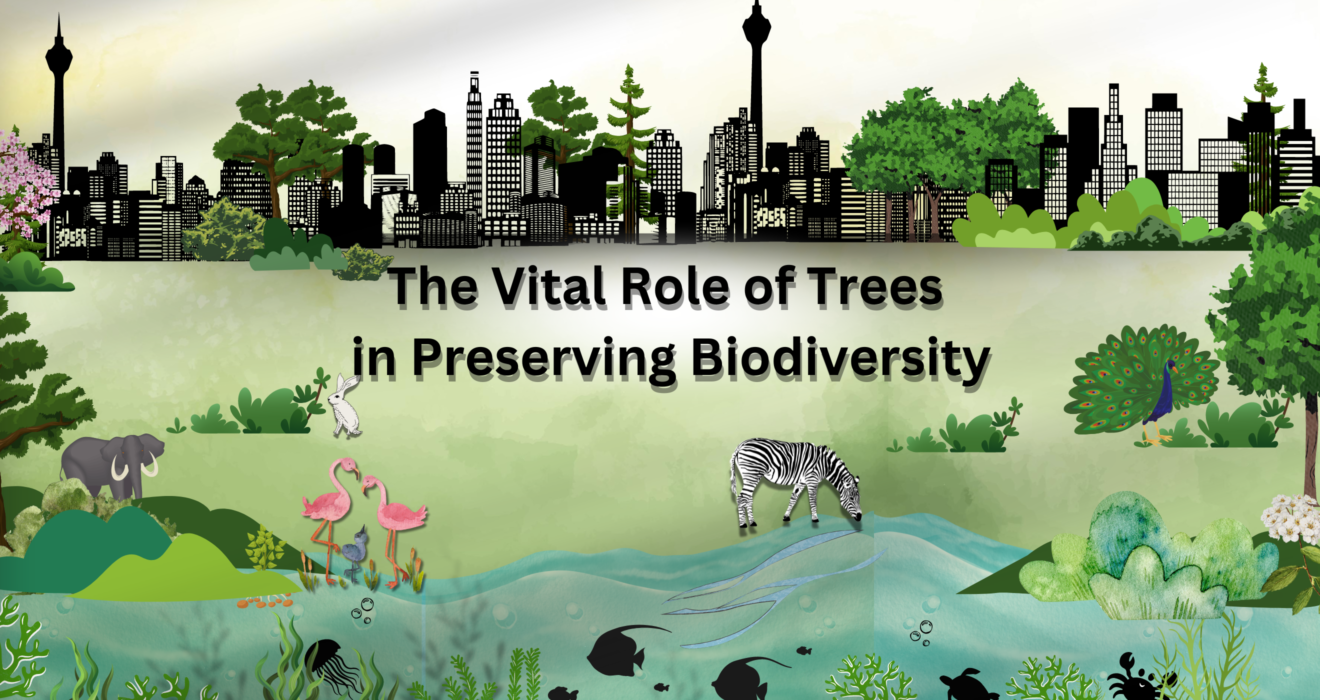Trees provide vital habitat for a diverse array of plant and animal species, contributing to the richness and resilience of ecosystems. In fact, forests provide habitat for 80% of the world’s biodiversity . However, the loss of tree cover threatens biodiversity and disrupts the delicate balance of natural systems. The consequences of this loss are far-reaching, with cascading effects on ecosystem function, climate regulation, and human well-being.
In our previous blog, we explored the connection between tree cover and public health outcomes, and today we’re delving deeper into the role of trees in preserving biodiversity
Let’s take the example of the Western Ghats, a mountain range in India, which is home to a staggering array of biodiversity. This region is often referred to as a “hotspot” due to its exceptional concentration of endemic species. The Western Ghats are home to over 5,000 species of flowering plants, 139 species of mammals, 500 species of birds, and 179 species of amphibians . However, the Western Ghats are facing an unprecedented threat due to widespread deforestation and habitat fragmentation. The loss of tree cover in this region has resulted in the decline of many species, including the critically endangered lion-tailed macaque and the Nilgiri tahr.
The loss of tree cover in the Western Ghats has far-reaching consequences, including habitat loss and fragmentation, disruption of ecosystem services, and climate change. 15% of all greenhouse gas emissions are caused by deforestation, which contributes to climate change. Moreover, 1 million species are facing extinction due to human activities, highlighting the urgent need for conservation efforts.This loss of forest cover not only affects biodiversity but also has significant implications for ecosystem services and human well-being. Through comprehensive tree censuses, researchers and conservationists gain valuable insights into tree species diversity and distribution patterns, enabling them to develop targeted conservation strategies.
The Role of Tree Censuses in Conservation
To address the loss of tree cover and biodiversity, we need to adopt a multi-pronged approach. Conducting regular tree censuses we can better understand the complex relationships between tree cover, public health, and biodiversity, as we discussed in our previous blog , also can help identify areas of high biodiversity, track changes in tree populations, and inform conservation strategies. Establishing protected areas, such as national parks and wildlife sanctuaries, can provide a safe haven for threatened species and preserve ecosystem integrity. Promoting sustainable forest management practices, such as selective logging and reforestation, can help maintain forest cover and reduce the risk of biodiversity loss. Finally, engaging local communities in conservation efforts can help raise awareness, build support, and ensure the long-term success of biodiversity conservation initiatives.
Did you know ? Trees can communicate with each other through underground networks of fungi and roots
The Indian Forestry Minister’s Tree Census Initiative
In a significant initiative, the Indian Forestry Minister has conducted a comprehensive tree census over the last 10 years, providing valuable insights into India’s forest ecosystem. The census was conducted using a combination of remote sensing technology, field surveys, and statistical analysis. The process involved:
- Identifying forest areas and estimating tree cover using satellite imagery
- Conducting field surveys by teams of foresters and researchers to collect data on tree species, density, and health
- Analyzing the data using statistical models to estimate tree numbers, species distribution, and forest health
The census revealed that India’s forest cover has increased by 1.57% between 2015 and 2017, with a total of 712,249 sq km (21.67% of the country’s geographical area) under forest cover. Notably, Andhra Pradesh has shown a significant increase in forest cover, from 22.41% in 2015 to 24.56% in 2017, thanks to concerted efforts by the state government and local communities. Madhya Pradesh has the highest forest cover in the country, with around 31% of its geographical area under forest cover.
However, the census also highlighted areas of concern, with around 15% of India’s forests being degraded, characterized by poor tree health and low density. To address this, over 2.5 billion trees were planted across the country between 2015 and 2019, with a survival rate of around 70%. The tree census has informed policy decisions and conservation efforts, raising awareness about the importance of forests and involving local communities in conservation. The data collected has also helped policymakers identify areas of concern and develop targeted conservation strategies.
Forests cover around 30% of the Earth’s land area
The Time to Act is Now :
The loss of tree cover and biodiversity is a pressing issue that requires immediate attention. To address this, a comprehensive tree census is crucial. This involves mapping and counting trees, identifying species, and assessing their health. A tree census provides valuable data to inform conservation efforts and track the effectiveness of reforestation programs.
Conducting a tree census requires collaboration between governments, NGOs, local communities, and individuals. We need to invest in technology, provide training and resources, and raise awareness about the importance of trees. The time to act is now – let’s work together to protect and preserve our natural world for future generations.

Written by
Anjeeta Goud
Team Business Development and Strategy
Terracon Ecotech
Reference:
https://www.hindustantimes.com/cities/delhi-news/mcd-counts-198-000-trees-in-first-tree-census-101712255381480.html
https://timesofindia.indiatimes.com/city/delhi/forest-dept-to-conduct-tree-census-in-capital/articleshow/103526560.cms
https://www.ifpindia.org/projects/western-ghats-portal-india-biodiversity-portal/
https://fsi.nic.in/forest-report-2017
https://www.ipbes.net/global-assessment
https://www.ipcc.ch/2019/#:~:text=The%20IPCC%20Special%20Report%20on,in%20the%202015%20Paris%20Agreement.
https://www.worldwildlife.org/publications/living-planet-report-2020




